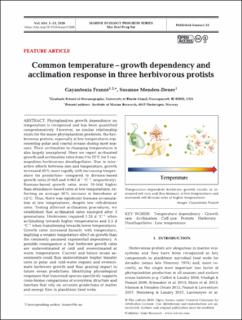| dc.description.abstract | Phytoplankton growth dependence on temperature is recognized and has been quantified comprehensively. However, no similar relationship exists for the major phytoplankton predators, the herbivorous protists, especially at low temperatures representing polar and coastal oceans during most seasons. Their acclimation to changing temperatures is also largely unexplored. Here we report acclimated growth and acclimation rates from 0 to 22°C for 3 cosmopolitan herbivorous dinoflagellates. Due to interactive effects between size and temperature, growth increased 40% more rapidly with increasing temperature for production- compared to division-based growth rates (0.043 and 0.062 d-1 °C-1, respectively). Biomass-based growth rates were 10-fold higher than abundance-based rates at low temperatures, reflecting an average 50% increase in biovolume at ≤2°C. Thus, there was significant biomass accumulation at low temperatures, despite low cell-division rates. Testing different acclimation procedures, we established that acclimated rates emerged after 3 generations. Herbivores required 1.25 d °C-1 when acclimating towards higher temperatures and 2.5 d °C-1 when transitioning towards lower temperatures. Growth rates increased linearly with temperature, implying a weaker temperature effect on growth than the commonly assumed exponential dependency. A possible consequence is that herbivore growth rates are underestimated at cold and overestimated at warm temperatures. Current and future ocean assessments could thus underestimate trophic transfer rates in polar and cold-water regions and overestimate herbivore growth and thus grazing impact in future ocean predictions. Identifying physiological responses that transcend species-specificity supports cross-biome comparisons of ecosystem structure and function that rely on accurate predictions of matter and energy flow in planktonic food webs. | en_US |
